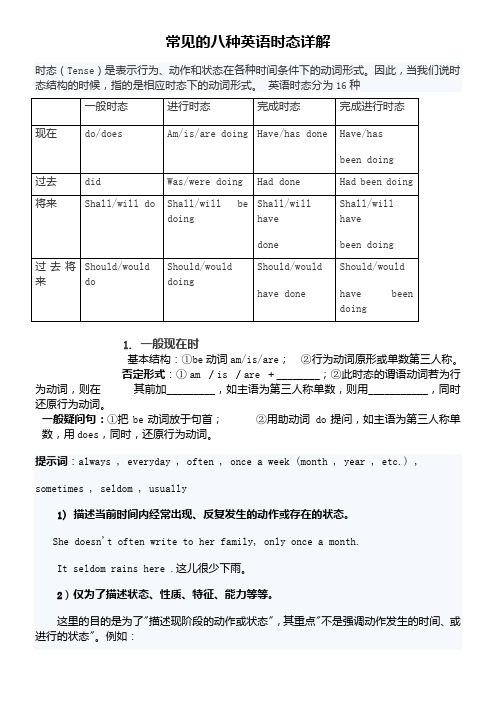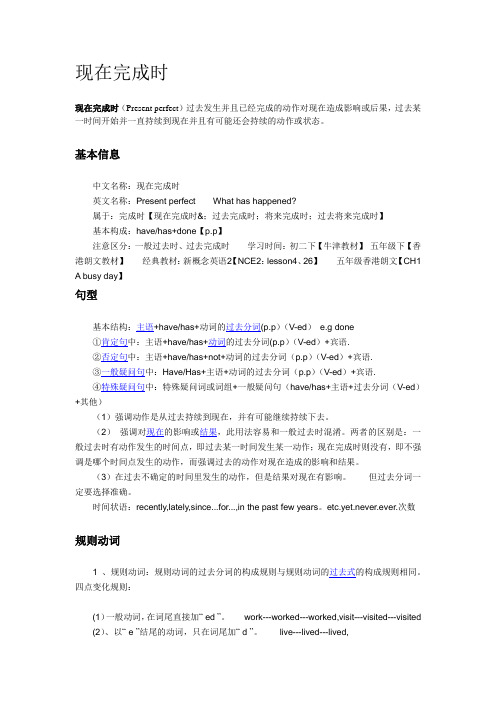16种时态的英文表达
- 格式:docx
- 大小:7.44 KB
- 文档页数:2

英语中的16种时态英语时态分为16种,下面就为大家一一列举:1、一般现在时态:表示现在的状态,或者经常反复发生的动作或习惯。
例如:I am a student.我是一名学生。
2、现在进行时态:表示正在进行的动作或存在的状态。
例如:He is studying.他在学习。
3、现在完成时态:表示过去发生的动作对现在造成的影响或结果。
例如:I have finished my homework.我已经完成了我的作业。
4、现在完成进行时态:表示从过去开始一直持续到现在的动作或状态。
例如:We have been waiting for you for hours.我们已经等了你几个小时了。
5、过去一般时态:表示过去某个时间点的状态或动作。
例如:He wasa teacher.他是一名老师。
6、过去进行时态:表示过去某个时间点正在进行的动作或存在的状态。
例如:They were playing football at that time.他们在那个时候正在踢足球。
7、过去完成时态:表示过去的过去,即过去某一时间之前发生的动作或状态。
例如:They had finished their work before we arrived.在我们到达之前,他们已经完成了他们的工作。
8、过去完成进行时态:表示过去某一时间之前一直在进行的动作或状态。
例如:We had been waiting for the bus for hours before it finally arrived.在公共汽车最终到达之前,我们已经等了好几个小时。
9、将来一般时态:表示将来某个时间点的状态或动作。
例如:She will be a doctor.她将成为一名医生。
10、将来进行时态:表示将来某个时间点正在进行的动作或存在的状态。
例如:We will be studying in the library tomorrow afternoon.我们明天下午将在图书馆学习。

常见的八种英语时态详解时态(Tense)是表示行为、动作和状态在各种时间条件下的动词形式。
因此,当我们说时态结构的时候,指的是相应时态下的动词形式。
英语时态分为16种1. 一般现在时基本结构:①be动词am/is/are;②行为动词原形或单数第三人称。
否定形式:① am /is /are +________;②此时态的谓语动词若为行为动词,则在其前加_________,如主语为第三人称单数,则用___________,同时还原行为动词。
一般疑问句:①把be动词放于句首;②用助动词 do提问,如主语为第三人称单数,用does,同时,还原行为动词。
提示词:always , everyday , often , once a week (month , year , etc.) , sometimes , seldom , usually1) 描述当前时间内经常出现、反复发生的动作或存在的状态。
She doesn't often write to her family, only once a month.It seldom rains here .这儿很少下雨。
2)仅为了描述状态、性质、特征、能力等等。
这里的目的是为了"描述现阶段的动作或状态",其重点"不是强调动作发生的时间、或进行的状态"。
例如:He can speak five foreign languages .Changjiang River is one of the longest rivers in the world.3) 陈述客观事实、客观真理。
The earth goes around the sun .地球绕着太阳转。
4) 根据英文语法规定,当主句的谓语动词是一般将来时,那么时间或条件状语从句的谓语动词只能用一般现在时来表示将来要发生的动作。
例如:I'll tell him the news when he comes back. 他回来时,我将告诉他这个消息。

英语16种时态英文表达1. 现在时态 (Simple Present Tense):I eat pizza every Friday. (我每个星期五吃披萨。
)2. 过去时态 (Simple Past Tense):She went to the park yesterday. (她昨天去了公园。
)3. 将来时态 (Simple Future Tense):They will travel to Europe next month. (他们下个月将去欧洲旅行。
)4. 现在进行时态 (Present Continuous Tense):We are studying for the exam right now. (我们现在正在为考试而学习。
)5. 过去进行时态 (Past Continuous Tense):He was watching TV when I called him. (我给他打电话时,他正在看电视。
)6. 将来进行时态 (Future Continuous Tense):They will be working on the project all night. (他们将整个晚上都在做这个项目。
)7. 现在完成时态 (Present Perfect Tense):I have already finished my homework. (我已经完成了我的作业。
)8. 过去完成时态 (Past Perfect Tense):She had already left when I arrived. (当我到达时,她已经离开了。
)9. 将来完成时态 (Future Perfect Tense):They will have finished their work by tomorrow. (他们到明天之前会已经完成他们的工作。
)10. 现在完成进行时态 (Present Perfect Continuous Tense):I have been studying English for two hours. (我已经学习英语两个小时了。

高考英语语法填空进行时态知识点与必记的单词(经典版)编制人:__________________审核人:__________________审批人:__________________编制单位:__________________编制时间:____年____月____日序言下载提示:该文档是本店铺精心编制而成的,希望大家下载后,能够帮助大家解决实际问题。
文档下载后可定制修改,请根据实际需要进行调整和使用,谢谢!并且,本店铺为大家提供各种类型的经典范文,如演讲稿、总结报告、合同协议、方案大全、工作计划、学习计划、条据书信、致辞讲话、教学资料、作文大全、其他范文等等,想了解不同范文格式和写法,敬请关注!Download tips: This document is carefully compiled by this editor. I hope that after you download it, it can help you solve practical problems. The document can be customized and modified after downloading, please adjust and use it according to actual needs, thank you!In addition, this shop provides you with various types of classic sample essays, such as speech drafts, summary reports, contract agreements, project plans, work plans, study plans, letter letters, speeches, teaching materials, essays, other sample essays, etc. Want to know the format and writing of different sample essays, so stay tuned!高考英语语法填空进行时态知识点与必记的单词时态(tense)是一种动词形式,不同的时态用以表示不同的时间与方式。

英文表格中短语的时态英语16种时态表格总结加例句1.一般现在时:do①表经常发生的动作I always help others(我常帮助他人)②表客观事实、真理The sun rises in the east(太阳从东边升起)③表知觉,状态I have a book (我有一本书)2.一般过去时:did表过去的发生的动作,状态或习惯I saw him yesterday(昨天我看到了他)3.一般将来时:will do表将来发生的动作或状态He will live in a big city(他将居住在大城市)注意:有连词when、unless、if、once所引导的状语从句表某条件时,一定要用一般现在时,而主句用一般将来时4.进行时现在进行时:be(is、am、are)doing过去进行时:was/were doing将来进行时:will be doing现在进行时:be(is、am、are)doing表示现在时刻正在进行的动作He is writing a letter.(他正在写一封信)5.过去进行时:was/were doing表过去某时刻正在进行的动作He was taking a bath when you called.(你打电话来时他正在洗澡)6.将来进行时:will be doing表将来某个时间正在发生的动作This time next day they will be sitting in the cinema.(明天这个时候他们会坐在电影院里)7.完成时现在完成时:have/has done过去完成时:had done将来完成时:will have done现在完成时:have/has done(过去分词)完成状态:用以表示到现在为止完成的动作(动作不延续,瞬间完成或时间很短)She has already come (她已经来了)未完成状态:用以表示过去某一时间开始到现在为止仍在继续的动作或状态(适用于延续性的动作)She has livedhere for 10 years. (她已经在这里住了10年了),8.过去完成时:had done用以表示截至过去某时为止所完成的动作或状态例1. He had already left when I came.(我来时他已经离开了)注意:过去完成时不能单独存在,要与另一个一般过去时或表过去的副词短语连用,即呈现过去不同时间发生的两个动作,先发生的用过去完成时,后发生的用一般过去时。

现在完成时现在完成时(Present perfect)过去发生并且已经完成的动作对现在造成影响或后果,过去某一时间开始并一直持续到现在并且有可能还会持续的动作或状态。
基本信息中文名称:现在完成时英文名称:Present perfect What has happened?属于:完成时【现在完成时&;过去完成时;将来完成时;过去将来完成时】基本构成:have/has+done【p.p】注意区分:一般过去时、过去完成时学习时间:初二下【牛津教材】五年级下【香港朗文教材】经典教材:新概念英语2【NCE2:lesson4、26】五年级香港朗文【CH1 A busy day】句型基本结构:主语+have/has+动词的过去分词(p.p)(V-ed)e.g done①肯定句中:主语+have/has+动词的过去分词(p.p)(V-ed)+宾语.②否定句中:主语+have/has+not+动词的过去分词(p.p)(V-ed)+宾语.③一般疑问句中:Have/Has+主语+动词的过去分词(p.p)(V-ed)+宾语.④特殊疑问句中:特殊疑问词或词组+一般疑问句(have/has+主语+过去分词(V-ed)+其他)(1)强调动作是从过去持续到现在,并有可能继续持续下去。
(2)强调对现在的影响或结果,此用法容易和一般过去时混淆。
两者的区别是:一般过去时有动作发生的时间点,即过去某一时间发生某一动作;现在完成时则没有,即不强调是哪个时间点发生的动作,而强调过去的动作对现在造成的影响和结果。
(3)在过去不确定的时间里发生的动作,但是结果对现在有影响。
但过去分词一定要选择准确。
时间状语:recently,lately,since...for...,in the past few years。
etc.yet.never.ever.次数规则动词1 、规则动词:规则动词的过去分词的构成规则与规则动词的过去式的构成规则相同。
十六种时态的英语表达以下是英语中常见的十六种时态的表达:1. 一般现在时(Simple Present): I play tennis every Sunday.2. 现在进行时(Present Continuous): She is studying for her exam right now.3. 一般过去时(Simple Past): They went to the beach last summer.4. 过去进行时(Past Continuous): He was eating dinner when the phone rang.5. 现在完成时(Present Perfect): We have lived here for five years.6. 过去完成时(Past Perfect): She had already finished her work before I arrived.7. 将来时(Future Simple): They will travel to Europe next month.8. 将来进行时(Future Continuous): I will be waiting for you at the airport.9. 将来完成时(Future Perfect): By this time tomorrow, she will have completed the project.10. 现在完成进行时(Present Perfect Continuous): Hehas been studying English for two hours.11. 过去完成进行时(Past Perfect Continuous): She had been working all day when I saw her.12. 过去将来时(Future in the Past): He said he would call me later.13. 过去将来进行时(Future Continuous in the Past): She said she would be cooking dinner at that time.14. 一般条件时(Zero Conditional): If it rains, the ground gets wet.15. 现在条件时(First Conditional): If she studies hard, she will pass the exam.16. 过去条件时(Second Conditional): If I won the lottery, I would travel around the world.。
16种时态的英语表达学习英语时态是非常重要的,因为时态可以表达不同的时间和情境。
英语有16种时态,包括简单时态、进行时态、完成时态、完成进行时态等。
以下是这些时态的英语表达:1. 简单现在时态 - Present Simple Tense(1) I eat breakfast at 7 am every day.(2) She always goes to bed early.2. 简单过去时态 - Past Simple Tense(1) I walked to school yesterday.(2) They visited their grandparents last weekend.3. 简单将来时态 - Future Simple Tense(1) I will see you tomorrow.(2) She is going to travel to Australia next month.4. 现在进行时态 - Present Continuous Tense(1) I am studying for my exam.(2) They are playing soccer in the park.5. 过去进行时态 - Past Continuous Tense(1) I was watching TV when she called.(2) They were studying all night.6. 将来进行时态 - Future Continuous Tense(1) I will be studying for my exam tomorrow.(2) They will be traveling to Europe next summer.7. 现在完成时态 - Present Perfect Tense(1) I have eaten breakfast already.(2) She has seen that movie twice.8. 过去完成时态 - Past Perfect Tense(1) I had finished my homework before dinner.(2) They had already left when we arrived.9. 将来完成时态 - Future Perfect Tense(1) I will have finished my project by next week.(2) She will have studied English for five years by next month.10. 现在完成进行时态 - Present Perfect Continuous Tense(1) I have been studying for two hours.(2) They have been playing video games all day.11. 过去完成进行时态 - Past Perfect Continuous Tense(1) I had been waiting for an hour before she arrived.(2) They had been studying for the final exam for weeks.12. 将来完成进行时态 - Future Perfect Continuous Tense (1) I will have been studying for six hours by the time the exam starts.(2) They will have been working on the project for a week by Friday.13. 现在完成完成时态 - Present Perfect Perfect Tense(1) I have had breakfast.(2) She has had a lot of experiences in her life.14. 过去完成完成时态 - Past Perfect Perfect Tense(1) I had had enough sleep before I went to work.(2) They had had a great time on their vacation.15. 将来完成完成时态 - Future Perfect Perfect Tense(1) I will have had enough practice by the time of the competition.(2) They will have had a successful year by the end of December.16. 直接引语 - Direct Speech(1) He said, 'I am happy to see you.'(2) She said, 'I will call you later.'以上是16种时态的英语表达,了解并掌握这些时态的用法对英语学习非常有益。
1. 一般现在时:I play basketball every day.2. 现在进行时:She is watching TV right now.3. 一般过去时:He went to the store yesterday.4. 过去进行时:They were playing soccer when it started raining.5. 现在完成时:I have finished my homework.6. 过去完成时:She had already eaten dinner when I arrived.7. 将来进行时:They will be studying for their exams all night.8. 将来完成时:By this time next year, he will have graduated from college.9. 现在完成进行时:I have been studying English for three years.10. 过去完成进行时:They had been waiting for the bus for an hour when it finally arrived.11. 一般将来时:I will go to the gym tomorrow.12. 将来进行时:We will be traveling to Europe next month.13. 一般过去将来时:He said he would call me later that day.14. 过去将来进行时:She knew they would be waiting for her at the airport when she landed.15. 现在完成将来时:I will have finished my project by the end of the week.16. 过去完成将来时:She had hoped they would be able to come to her wedding, but they couldn't make it.。